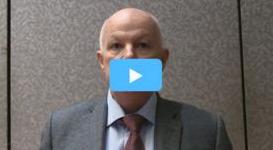Advertisment
ILTS 2016: Professor John O’Grady (Kings College Hospital, London) discusses current practices in managing HCV. Also included associated article.

Treating patients with Hepatitis C infections who are on the liver transplant waiting list is not a given
by Thomas R. Collins:
What if patients are too sick to be treated, but improve just enough in MELD score to drop down in priority on the waiting list, leaving them in so-called “MELD purgatory” and preventing them from getting a transplant? Would it be better to be able to accept a liver from a Hepatitis C-positive donor, because it would increase your potential donor pool? Are the treatment outcomes better after transplantation, so that it makes more sense to wait?
Two experts debated these questions here at the 22nd Annual Meeting of the International Liver Transplantation Society.
In the debate, Michael Charlton MD, a transplant hepatologist at Intermountain Healthcare in the U.S., said that data from ASTRAL4, a trial enrolling patients taking subosbuvir (SUB) and velpatasvir (VEL) with and without ribavirin (RIB), shows that patients can be treated effectively with direct-acting antivirals. For 82 of the 87 patients on SUB/VEL plus RIB, there was a sustained viral response (SVR) for 12 weeks, or longer.
“They’re certainly not too sick to be treated,” he said.
As for expanding the donor pool by remaining eligible to receive HCV-positive donor grafts, he pointed to a 2011 study involving about 14,000 potential organ donors over 4 years at 17 organ procurement organizations in the U.S. Researchers found that the prevalence of normal-risk Hep C donors was 3.5% and high-risk Hep C donor prevalence was 18%. Among living donors, the prevalence was 3.6%.
“So waiting for Hep C positive donors at best could increase the donor pool by about 4%,” he said.
A 4% increase in potential donors would mean one more donor every 3 months in a program that does 100 transplants in a year, Dr. Charlton said.
He said that using conservative estimates, treating patients with Hep C with a MELD of 20 or higher would result in 27 patients alive and 3 dead one month after transplant, and 55 alive and 15 dead 12 months after not receiving a transplant.
Factoring in a slightly larger donor pool for those not receiving treatment, 31 would be alive and 3 dead one month after transplant, along with 36 alive and 30 dead 12 months later after not receiving a transplant and not receiving Hep C treatment, he said.
In other words, 15 more patients would die in the no-treatment scenario compared to the treatment scenario, Dr. Charlton said.
“I would argue based on this data that we should treat (HCV-positive) patients with MELD scores of 20 to 29,” he said.
Dr Marina Berenguer, a Consultant Hepatologist at La Fe University Hospital in Valencia, Spain, argued that treating Hep C is not always such a rosy picture. Take, she said, the example of a wait-listed 65-year-old man with HCV and a MELD of 27 who achieves an SVR12 and whose MELD drops to 24, but still has persistent ascites and encephalopathy. The patient ends up dying from sepsis due to a bacterial infection.
Another scenario without a good ending: a patient performs well on the direct-acting anti-virals, is de-listed, then ends up dying from hepatocellular carcinoma.
“These cases really highlight the problem of treating all the patients on the waiting list,” Dr. Berenguer said. “All the patients on the waiting list are not the same. There’s a spectrum of disease severity.”
The bottom line, she said, is that “not everybody improves with these drugs.”
Problems being seen in patients include clinical decompensation and hepatic decompensation, she said.
“We are seeing more papers being published now that the drugs are licensed, really focusing on some problems in terms of safety,” Dr. Berenguer said.
She also noted that the trials on the drugs, including ASTRAL4, tended to include a very small percentage of patients with MELD scores above 15 or 20.
“We really don’t have a lot of information about the efficacy and mostly toxicity in patients with very advanced stages of liver disease,” she said.
Treating post-transplant comes with several advantages, she said.
“We have extremely high SVR rates particularly with patients at low fibrosis scores early after transplant,” she said. “Drug-drug interactions might be present but they’re easily manageable. There’s also the issue of cost-efficiency with only treating patients that really make it through the transplant. Finally, although I don’t think this is a problem for many countries, there’s a potential increase in the donor pool with the anti-HCV positive donors.”
References
Kalafateli M, Dusheiko G, Manousou P. Clinical decompensation after achieving SVR with sofosbuvir, daclatasvir and ribavirin in a patient with recurrent HCV post-liver transplant. J Gastrointestin Liver Dis. 2015 Jun;24(2):257-8.
Stine JG, Intagliata N, Shah NL, et al. Hepatic decompensation likely attributable to simeprevir in patients with advanced cirrhosis. Dig Dis Sci. 2015 Apr;60(4):1031-5.





